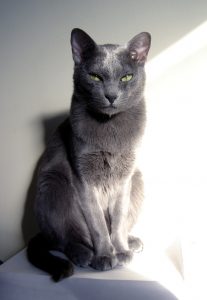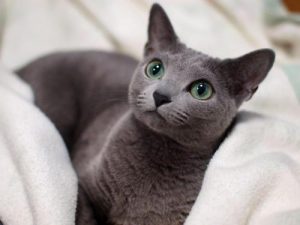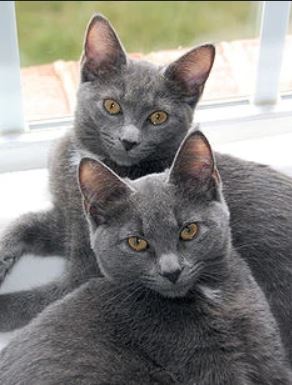Korat
Korats, The Good Luck Cats From Thailand
 A Rare and Friendly Breed of Cat
A Rare and Friendly Breed of Cat
The Korat Cat breed, which is also referred to in their native Thailand as the Si-Sawat (or Si Sawat), are frequently called the “good luck cats” owning to their historic name and limited gene pool. They are rare even in Thailand. Alternative names of the breed are Khorat, Malet, Maleht.
A very stable oriental cat, they are primarily identified immediately by their beautiful, blue-grey with silver-tipped fur that appears to shimmer which, according to the Cat Fanciers’ Association, gives them the appearance of having a halo-looking appearance which is quite distinctive. The color of Si-Sawats’ hair is compared to grey nickernuts, or sawat seeds, i.e. beans of Gray Nicker, hence the name is Si-Sawat (meaning “the color of sawat seed”). Thai people also describe it as the color of a rain cloud, dark blue/grey. Korats shine like silver and have heart-shaped head and nose and even their chest forms as a shape of a heart.
Origin and History of the Si-Sawat Cat Breed
Also known as Siam cats, Korats are referred to in an ancient Thai book called “Cat-Book Poems” (Tamra Maew), which dates back to the Ayutthaya period of 1350 to 1767 in Thailand, so the breed has been in existence for some time.
Korat cat breeds were often given as gifts to brides upon their wedding as a symbol of good luck and good fortune for their future household with their husband and presumably children, so Korats spread rapidly in Thailand.
However, it wasn’t until 1959, that a pair of Korats were first imported to the USA. In the early 1970s, Korats began to come to the UK, and now the breed, although fairly rare, is found in many different countries.
Types of Breeds
Korats are a pure feline breed, but the Governing Council of the Cat Fancy does list experimental Korats, delineated by their color. In place of the traditional solid blue, recognizing Korat sub-breeds that are Thai Lilac and Thai Blue Point, having slightly different coloring shades than the traditional pure-bred Korat.
The Appearance of a Korat
 These Thai cats are medium-sized cats weighing 6 to 10 pounds and around 15 to 18 inches in length. They have green or amber eyes and large forward-facing ears.
These Thai cats are medium-sized cats weighing 6 to 10 pounds and around 15 to 18 inches in length. They have green or amber eyes and large forward-facing ears.
Their heads often look heart-shaped when viewed from the front, and combined with their striking hair, they are quite beautiful.
A Korat’s Personality
Korats simply love people and bond with them quite easily. They love to be held and cuddled and are content living in large families which is ideal for the typical Thai family.
They easily accommodate living with other cats and are just as comfortable cuddling as they are exploring and participating in cat games.
Providing the children in the family are socialized to treat your cat lovingly, they love children and adults equally.
The Lifespan of Korats
Korats tend to live a long life, with 18 or 19 years an expected lifespan. They also tend to be quite healthy, acquiring few of the diseases that affect other cat breeds.
Korats, with their warm temperament, are a fantastic cat breed to consider owning, and owners may or may not be brought good luck by owning the species, but they certainly will be rewarded with a loving cat that brings plenty of love to your household.
Differences Between Korat Cat Breed and Russian Blue
These cat breeds are visually similar but have differences. Many often find it difficult to distinguish them. Here are some differences and similarities that you can notice:
– They both have similar color of fur and eyes;
– The heart-shaped head of Korat and wedge-shaped head of Russian Blue;
– Korat doesn’t have a downy undercoat, but the Russian Blue has it and looks more fluffy than Korat because of it;
– Korat is a cat from a tropical country (Thailand), Russian Blue is from a cold Siberian city (Russia).

